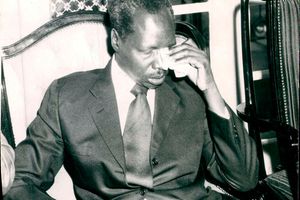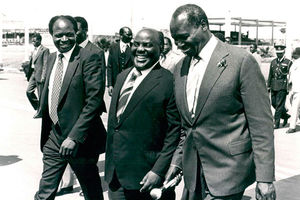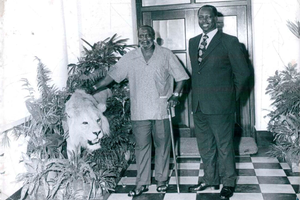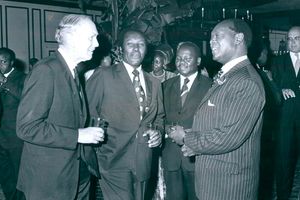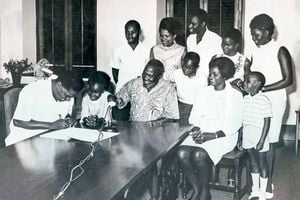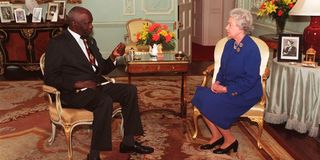
President Daniel arap Moi with Queen Elizabeth II at Buckingham Palace in London, on November 25, 1998.
On November 25, 1989, Her Majesty’s customs officials at Heathrow Airport in London seized an Israeli-made Uzi submachine gun from President Daniel Arap Moi’s bodyguards, declassified documents reveal.
The machine gun serial number 01092 was seized on grounds that its importation contravened UK firearms regulations and procedures governing the import of weapons.
Moi and his delegation, which also included armed elite guards, had arrived in London on November 21, 1989 for a four-day visit aboard Kenya Airways flight KQ 113.
As required by British laws, the bodyguards surrendered their weapons in two sealed boxes for examination and custody by customs officials at Heathrow and were given receipt number AO 013259.
The declaration form attached to the sealed boxes showed that they contained nine handguns serial numbers AO 013259 275960, 27938, 245py01831, T275954, T075946, 136835 and T092118 and 01092.
The form also showed that the boxes had 242 rounds and 18 magazines. Britain has some of the strictest gun laws in the world. For a very long time, not even the minders of the President of the United States were allowed to carry weapons in the country.
This only changed after the July 7, 2005, London terrorist bombings when the US began to pile pressure on the British government to allow its agents to carry weapons.
“Once it became apparent we had a very serious problem with homegrown al-Qaeda terrorism, it was very hard not to give ground,” one British official said in 2010, while Commander Bob Broadhurst of the London Metropolitan Police, responding to a question about this change of policy, stated: “The request is always asked and nearly always declined. Occasionally, with the US, there are a number allowed, one or two close officers, to carry a firearm.”
The Firearms Act 1968 laws are not only strict on the importation and the possession of weapons, but also on the type of gun. While initially there was no any formula for the determination of a dangerous gun, reassessments of the dangerousness of certain guns has been made periodically.
For example, shotguns were exempt from certification until 1967 when it was realised that it was the most used weapon in gun crime.
Similarly, in 1987, when Michael Ryan, armed with shotguns and semi-automatic rifles, went on a shooting spree killing 16 people in what is today known as the Hungerford massacre, certain self-loading and pump-action rifles and shotguns were categorised as prohibited weapons.
A section of the Firearms (Amendment) Act 1988 which was introduced after the tragedy stated that prohibited weapons and ammunition, “includes weapons such as machine guns, sub-machine guns, chain guns and the so called ‘burst fire ‘weapons in which several missiles (typically 3-5) are discharged in succession on a single application of the trigger”.
This effectively made the Uzi submachine gun seized from Moi’s bodyguards, a prohibited weapon.
Designed by Major Uziel Gal for the Israeli military in the 1940s, the Uzi can operate both as a semi-automatic weapon firing one round per trigger and an automatic weapon firing up to 600 rounds per minute.
It was preferred by close protection security officers because its small, accurate, easy to use and effective. It was the standard submachine gun for the US Secret Service from the 1960s until early 1990s when it was phased out.
A 1976 defence periodical listed Kenya as one of Israel’s “16 client nations whose purchases ranged from small but efficient UZI submachine gun and Galil assault rifle to the battle tested Gabriel surface-to-surface missile”.
Nevertheless, as President Moi and his delegation retreated to their hotels, the customs officials carried out an examination of the contents of the boxes which revealed that among the guns was an Uzi machine gun, which is considered a prohibited weapon in the UK.
Consequently, it was seized and kept away in a separate armoury. The Kenyans only discovered the missing weapon on the day of their departure from the UK.
On November 25, 1989, as Moi prepared to jet back to Kenya after his trip, customs handed back the arms and the ammunition but without the UZI. It was during this time that the matter arose.
The offence here was failing to make a full declaration on arrival and importing a prohibited weapon under the Firearms Act 1968, which could lead to a maximum prison sentence of up to 10 years.

President Daniel arap Moi with Queen Elizabeth II (right) and the Queen Mother at a state banquet in Buckingham Palace on December 6, 1979.
For this, the blame was put squarely on the Captain of the Kenya Airways aircraft and President Moi’s escort commander.
Police and customs officials at Heathrow’s South Side where Moi and his delegation were departing from could not help since the gun was locked away in the armoury.
With the flight to Nairobi preparing to take off, the presidential escort commander was advised to leave the matter with the High Commissioner to follow up on their behalf.
The High Commission subsequently sought the assistance of the Foreign Office’s East African Department and Protocol Department who intervened by persuading the customs department to agree to the release of the weapon. Customs agreed on condition that the High Commission made a written application.
On December 1, 1989, M. Odengo of the High Commission wrote to the Customs and Excise Department apologising for the incident and pleading for the UZI machine gun to be returned.
“We are now writing, first to apologise for the incident and also to inform your office that this was not an intentional act,” he wrote.
“We are also praying that a similar incident shall not occur. Meanwhile, we do implore you to let us have the firearm in question and we shall make the necessary arrangements to export it to the relevant authority in Kenya.”
In her response, Mrs D. A. Davis of customs wrote: “I understand that in the incident concerned the advised procedures were not followed in that required declarations were not made fully on arrival.
Additionally, Uzi is one of the types of weapons which the UK considers to be particularly dangerous and the London Airport notice warns that such weapons will be seized either declared or not.”
Even though Mrs Davis stated that she was ready to consider the request, she issued a stern warning that a similar incident in future would not be tolerated and that Kenya Airways should familiarise itself with the new regulations.
“You have asked us to consider restoration of the firearm. On this occasion I am prepared to authorise its release. However, I trust that you will recognise that this is an exceptional course of action and that any future incident will not necessarily be given similar treatment. I do advise you to ensure that Kenya Airways are familiar with our procedure in order to avoid future problems,” she advised.
According to documents marked confidential, the Uzi machine gun was eventually released on December 22, 1989, and handed to Captain Mwangi of Kenya Airways who flew it to Nairobi on KQ flight 107.
The Foreign Office, which had played a great role in securing the release of the weapon, advised the British High Commissioner to Kenya, “Grateful if you will please also remind the president’s office of their responsibility to ensure that there is no recurrence. HM Customs will make no further exceptions and if any weapons are confiscated in future they will be retained for eventual destruction.”
The Foreign Office also instructed the British High Commissioner to warn President Moi’s office that any security officer accompanying a VIP was not immune to arrest and prosecution if found going against the gun laws.
“Security staff accompanying ViP visitors are not entitled to any form of immunity and are therefore liable to arrest and prosecution, such as fine or imprisonment, if they are found to be in contravention of the law.”
In his reply dated Jan 17, 1990, and marked confidential, the British High Commissioner wrote: “We have spoken to the President’s office, who fully take the point, and have assured us that this will never happen again.”

